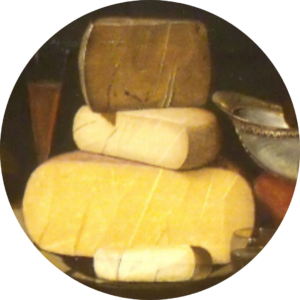What is
Origins and Development
- Pecorino Sardo, also known as Fiore Sardo, is a traditional Italian cheese made exclusively from the milk of Sardinian breed sheep.
- Its origins trace back several millennia, deeply rooted in the pastoral culture of Sardinia, an island known for its extensive sheep farming.
- Historically, it was primarily produced for local consumption by shepherds who developed a semi-hard cheese that could sustain through the seasons.
Traditional Methods
- The cheese is made using raw sheep’s milk, which contributes to its rich flavor. The milk is curdled with lamb rennet, reflecting ancient cheesemaking traditions.
- The curds are then cooked, pressed into molds, and salted. The cheese is smoked over aromatic woods and matured in cool, humid conditions, characteristic of Sardinian caves or cellars.
- Pecorino Sardo carries a PDO (Protected Designation of Origin) status since 1996, ensuring it is produced under strict guidelines to maintain quality and authenticity.
Age Profiles of Pecorino Sardo
Varieties
- Dolce (Sweet): Aged for a minimum of 20 to 60 days, this version is softer and has a more delicate flavor. It’s ideal for a wide range of culinary uses, from grating over dishes to slicing.
- Maturo (Mature): Aged for at least two months and often up to six months, this type is firmer and more piquant. It is favored for its richer and deeper sheep’s milk flavors.
Flavor and Texture
- Young Pecorino Sardo has a mild, creamy taste, while the mature version develops a stronger, spicier, and slightly nutty flavor.
- The texture varies from semi-soft and moist in younger cheeses to a crumbly and dense structure in older varieties.
Pecorino Sardo in America
Introduction and Availability
- Pecorino Sardo was introduced to the American market largely through specialty cheese shops and high-end grocery stores.
- It gained popularity in the U.S. particularly among gourmet food lovers and those with an appreciation for artisanal cheeses.
Culinary Uses
- In America, Pecorino Sardo is often used in recipes that call for robust, salty cheeses. It is particularly popular grated over pasta dishes, incorporated into salads, or served with honey and fruits as part of a cheese platter.
- The cheese is also a component in various Italian-American dishes where a strong, salty cheese is desired.
Market Trends
- Over the years, the presence of Pecorino Sardo in America has grown due to increasing consumer interest in traditional and authentic European cheeses.
- Its availability has been bolstered by the trend towards organic and PDO-certified products, which are perceived as higher quality and more sustainable.
Conclusion
Pecorino Sardo is not just a cheese but a reflection of Sardinian culture and pastoral traditions. With its rich history and distinct age profiles, it caters to a variety of tastes and uses, making it a beloved choice both in Italy and abroad, including in the United States. As consumers globally become more knowledgeable about the origins and production methods of the foods they consume, the appreciation for cheeses like Pecorino Sardo is likely to continue to grow, enhancing its market presence and culinary significance.
Tasting Notes
Here’s a detailed tasting notes table for Pecorino Sardo, broken down by various sensory and flavor characteristics:
| Category | Tasting Notes for Pecorino Sardo |
|---|---|
| Body and Texture | Depending on age: – Dolce: Semi-soft, creamy – Maturo: Firm, crumbly, dense |
| Notes on the Five Tastes | – Savouriness/Umami: Prominent, rich – Saltiness: High, especially in mature varieties – Sweetness: Mild, more noticeable in Dolce – Acidity/Sourness: Low, subtle tanginess – Bitterness: Very minimal, occasionally perceptible in aged types |
| Dairy Flavours | Pronounced sheep’s milk flavor; creamy and milky in younger cheeses, evolving to a more pronounced gamey taste in older ones |
| Notable Details on Other Flavours | Smoky notes from traditional smoking process; hints of nuts and a whiff of herbal tones from the natural pasture |
| Flavours Arising from Aging | – Dolce: Gently develops creaminess with a hint of earthiness – Maturo: Enhanced complexity, nuttiness, and a more pronounced smoked character; potential development of spicy undertones |
This table captures the essential sensory qualities of Pecorino Sardo, reflecting how its flavors and textures evolve from the Dolce to the Maturo varieties.
How is it made
Pecorino Sardo is characterized by a traditional cheesemaking and maturation process that distinctly shapes its flavor and texture. Here are the key distinguishing features of how Pecorino Sardo is traditionally made and matured:
- Sheep’s Milk: Made exclusively from the whole, raw milk of Sardinian sheep, which graze on the diverse flora of the island, imparting a unique flavor to the milk and the cheese.
- Coagulation: The milk is coagulated using lamb rennet, which is a traditional practice that influences the subtle flavors and texture of the cheese.
- Curds and Cooking: The curds are cut and then gently cooked, a step that helps achieve the desired firmness and expels additional whey, concentrating the flavors.
- Molding and Pressing: After cooking, the curds are placed in molds and pressed to shape the cheese and help remove any remaining whey, ensuring a denser texture in the final product.
- Salting and Smoking: The cheese is dry-salted by hand or brine-salted, which not only seasons the cheese but also aids in its preservation. Traditionally, Pecorino Sardo may be lightly smoked over aromatic woods, adding a distinct smoky flavor.
- Aging/Maturing:
- Dolce (Sweet) varieties are aged for at least 20 to 60 days, resulting in a softer texture and milder flavor.
- Maturo (Mature) varieties are aged for a minimum of two months, often up to six months or longer, allowing for the development of a firmer texture and deeper flavors.
- PDO Status: Pecorino Sardo is a PDO (Protected Designation of Origin) cheese, meaning it must be produced according to specific methods and in a particular geographic area to ensure its authenticity and quality.
These traditional techniques are crucial in defining the characteristic profile of Pecorino Sardo, distinguishing it from other cheeses and highlighting its cultural and historical importance in Sardinia.
Different styles
Pecorino Sardo is available in two main age profiles, each offering distinct taste characteristics that cater to different preferences and culinary uses. Here’s a breakdown of the taste profiles for the different ages of Pecorino Sardo:
Pecorino Sardo Dolce (Sweet)
Age: 20 to 60 days
Texture: Semi-soft to soft, creamy
Flavor Profile:
- Primary Taste: Mild umami with a noticeable creaminess
- Saltiness: Moderate but not overpowering, enhances the milk’s natural flavors
- Sweetness: Subtle, with a gentle hint of sweetness from the fresh sheep’s milk
- Acidity: Slight tanginess that adds freshness without dominating
- Bitterness: Minimal to none, very smooth on the palate
Aromatic Notes:
- Dairy Flavors: Pronounced fresh cream and milk flavors, very dairy-forward
- Other Flavors: Hints of grass and herbs from the sheep’s pasture-based diet
Use: Ideal for melting over dishes, in sandwiches, or as a table cheese due to its mild and accessible flavor.
Pecorino Sardo Maturo (Mature)
Age: At least 2 months, commonly 6 months or more
Texture: Firm, can be crumbly with age
Flavor Profile:
- Primary Taste: Strong umami and pronounced savouriness
- Saltiness: Increased saltiness, which complements the richer flavors developed during aging
- Sweetness: Less noticeable, overshadowed by more robust savory notes
- Acidity: Reduced, with any tanginess giving way to deeper savory qualities
- Bitterness: Slightly more evident, especially in very well-aged cheeses, adding complexity
Aromatic Notes:
- Dairy Flavors: Intense sheep’s milk characteristics, with a pronounced gamey note
- Other Flavors: Enhanced nuttiness, possible hints of smokiness if smoked during production, with background notes of dried fruits or spices depending on the specifics of the aging environment
Use: Excellent for grating over pasta, risotto, or as a part of a sophisticated cheese platter, especially paired with strong wines, dried fruits, and nuts.
The aging process dramatically transforms Pecorino Sardo, moving it from a soft, creamy, and mild cheese in its Dolce form to a bold, complex, and crumbly cheese as it matures. This versatility makes Pecorino Sardo suitable for a variety of dishes and preferences.
Compare with other cheeses
Pecorino Sardo is a distinctive sheep’s milk cheese from Sardinia, Italy, known for its rich flavor and varied texture depending on age. It shares the stage with several other prominent sheep’s milk cheeses, both within Italy and internationally. Below is a comparison of Pecorino Sardo with other similar cheeses, including Italian Pecorinos, Idiazabal from Spain, and notable sheep milk cheeses made in the Americas.
| Cheese | Origin | Visual Appearance | Texture | Flavor Profile |
|---|---|---|---|---|
| Pecorino Sardo | Sardinia, Italy | Pale yellow; natural or smoked rind | Dolce: Semi-soft, creamy Maturo: Firm, crumbly | Dolce: Mild, creamy, hints of herbs Maturo: Rich, nutty, savory, possibly smoky |
| Pecorino Romano | Lazio, Italy | Pale straw color; hard, gritty rind | Hard, grainy | Very salty, sharp, slightly spicy; more intense than most pecorinos |
| Pecorino Toscano | Tuscany, Italy | Smooth, thin, pale rind | Soft to semi-hard depending on age | Young: Sweet, buttery Aged: Nutty, piquant |
| Pecorino Siciliano | Sicily, Italy | Dark yellow; hard rind | Hard, compact | Piquant, somewhat spicy, with a more pronounced animal character compared to other pecorinos |
| Idiazabal | Basque, Spain | Dark brown, smoked rind; often knotted | Firm, slightly elastic | Rich, buttery, smoky (if smoked); nutty and somewhat sharper when unsmoked |
| Manchego | La Mancha, Spain | Pale yellow; distinctive herringbone rind | Young: Soft, moist Aged: Firm, crumbly | Young: Mild, creamy Aged: Zesty, caramel notes, underlying tanginess |
| Ossau-Iraty | French Pyrenees | Smooth, natural rind; ivory color | Firm, slightly oily | Nutty, earthy, subtle hints of fruit and olive, with a sweeter and milder flavor than many other aged sheep’s milk cheeses |
| Roquefort | Southern France | Pale, with distinctive blue veins | Moist, crumbly | Tangy, salty, with a pronounced blue mold flavor that is pungent and sharp |
| Wisconsin Sheep Milk Cheese | Wisconsin, USA | Varies with type; often pale and natural | Varies widely, from soft to firm | Generally mild, creamy; some artisan versions may have more complex, earthy notes depending on the aging process |
This table highlights the diversity among sheep’s milk cheeses, particularly noting differences in visual characteristics, textures, and flavors. Pecorino Sardo stands out for its optional smoky qualities and the distinctive savory and nutty flavors that deepen with age, contrasting with other cheeses like Pecorino Romano’s sharp saltiness or Idiazabal’s optional smoky flavor.
What does it pair with
Here’s a detailed table suggesting traditional pairings of Pecorino Sardo with various wines and other drinks, including an explanation for why each pairing works well:
| Pecorino Sardo Type | Drink Pairing | Comparable Strength | Balance of Tastes | Harmony of Flavours | Textural Combination | Provenance/History |
|---|---|---|---|---|---|---|
| Dolce | Vermentino di Sardegna | Balanced; both are moderately intense | Cheese’s salt and umami balance wine’s acidity; subtle sweetness in both | Both share a fresh, crisp profile; herbal notes in wine complement the cheese | Soft cheese contrasts with the crisp, refreshing wine | Both from Sardinia, making this a regional pairing celebrating local flavors |
| Dolce | Sardinian Cannonau | Wine and cheese are well-matched in body | Cheese’s mild flavors softened by the fruity, slightly tannic wine | Earthy undertones in both the wine and cheese create a rustic pairing | Semi-soft cheese works well with the medium-bodied wine | Another Sardinian pairing, linking the island’s pastoral and viticultural heritage |
| Maturo | Aged Barolo | Both are robust and intense | Cheese’s strong savory flavors are mellowed by the wine’s complex, rich profile | Aged notes in both cheese and wine (like nuttiness and earthiness) enhance each other | Firm, crumbly cheese alongside a full-bodied, structured wine | Both are aged, traditional products from Italy, celebrated for their depth and complexity |
| Maturo | Vintage Port | Strong cheese with a strong, sweet wine | Salt and umami in cheese counterbalance the sweetness and acidity of the port | Rich, aged flavors in both offer a luxurious taste experience | The crumbly texture of the cheese absorbs and contrasts with the smooth, rich port | Luxurious pairing often reserved for special occasions, highlighting the best of aged European flavors |
| Both Dolce & Maturo | Italian Craft Beer (e.g., Ichnusa) | Varies with beer; generally well-matched with lighter beers for Dolce and darker ales for Maturo | Beer’s bitterness and carbonation cleanse the palate, balancing the cheese’s saltiness | Yeasty, malty flavors in beer complement the earthy tones in the cheese | Effervescence in beer contrasts with both the creamy and crumbly textures of the cheese | Combining Italian cheese with Italian beer celebrates the craft and tradition of Italian produce |
Each pairing is designed to enhance both the drink and the cheese, creating a harmonious balance of flavors, textures, and aromas that accentuate the qualities of both components.


